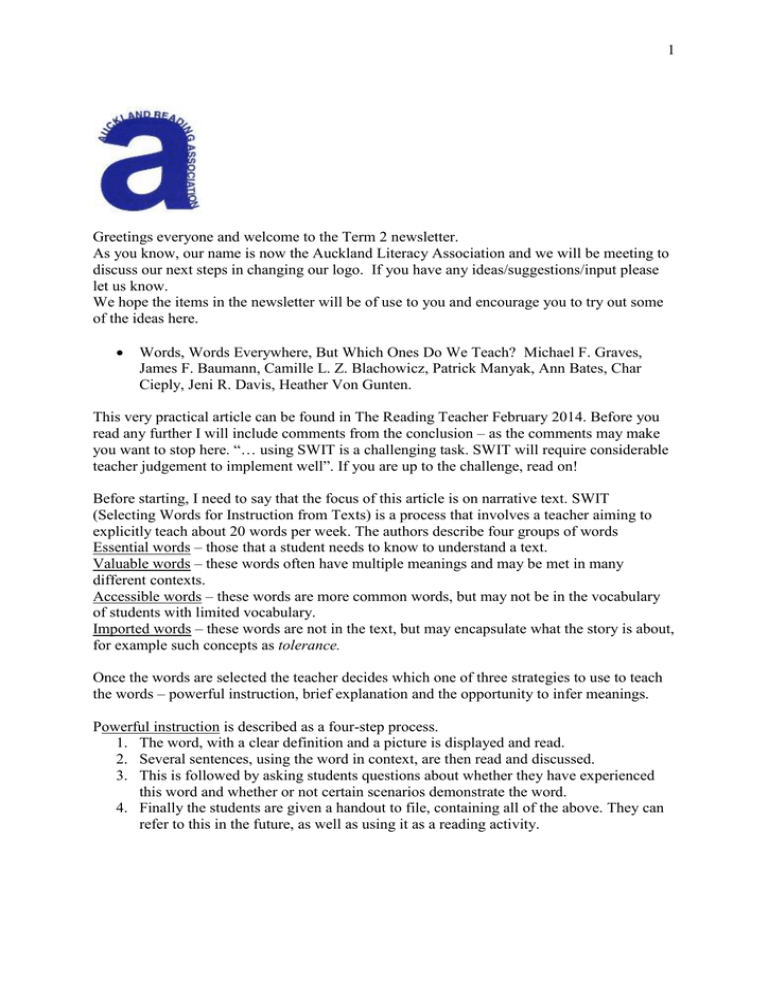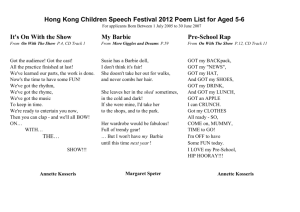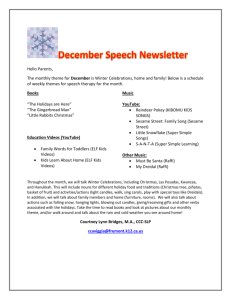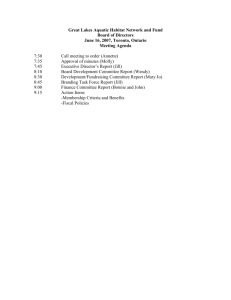Term 2 2014 Newsletter.doc - New Zealand Literacy Association
advertisement

1 Greetings everyone and welcome to the Term 2 newsletter. As you know, our name is now the Auckland Literacy Association and we will be meeting to discuss our next steps in changing our logo. If you have any ideas/suggestions/input please let us know. We hope the items in the newsletter will be of use to you and encourage you to try out some of the ideas here. Words, Words Everywhere, But Which Ones Do We Teach? Michael F. Graves, James F. Baumann, Camille L. Z. Blachowicz, Patrick Manyak, Ann Bates, Char Cieply, Jeni R. Davis, Heather Von Gunten. This very practical article can be found in The Reading Teacher February 2014. Before you read any further I will include comments from the conclusion – as the comments may make you want to stop here. “… using SWIT is a challenging task. SWIT will require considerable teacher judgement to implement well”. If you are up to the challenge, read on! Before starting, I need to say that the focus of this article is on narrative text. SWIT (Selecting Words for Instruction from Texts) is a process that involves a teacher aiming to explicitly teach about 20 words per week. The authors describe four groups of words Essential words – those that a student needs to know to understand a text. Valuable words – these words often have multiple meanings and may be met in many different contexts. Accessible words – these words are more common words, but may not be in the vocabulary of students with limited vocabulary. Imported words – these words are not in the text, but may encapsulate what the story is about, for example such concepts as tolerance. Once the words are selected the teacher decides which one of three strategies to use to teach the words – powerful instruction, brief explanation and the opportunity to infer meanings. Powerful instruction is described as a four-step process. 1. The word, with a clear definition and a picture is displayed and read. 2. Several sentences, using the word in context, are then read and discussed. 3. This is followed by asking students questions about whether they have experienced this word and whether or not certain scenarios demonstrate the word. 4. Finally the students are given a handout to file, containing all of the above. They can refer to this in the future, as well as using it as a reading activity. 2 Brief explanation This is exactly what it says. While the students are reading the teacher will provide a brief explanation of a few words that link together, encouraging students to support with their ideas. Infer meaning The teacher decides which words can be understood from using context clues and deliberately supports students to use this comprehension strategy, questioning and prompting. The authors conclude by reminding us that vocabulary knowledge is a critical component for achieving success in literacy, therefore teachers need to invest time in teaching vocabulary explicitly. Words, Words Everywhere, But Which Ones Do We Teach? Michael F. Graves, James F. Baumann, Camille L. Z. Blachowicz, Patrick Manyak, Ann Bates, Char Cieply, Jeni R. Davis, Heather Von Gunten. This very practical article can be found in The Reading Teacher February 2014. Before you read any further I will include comments from the conclusion – as the comments may make you want to stop here. “… using SWIT is a challenging task. SWIT will require considerable teacher judgement to implement well”. If you are up to the challenge, read on! Before starting, I need to say that the focus of this article is on both narrative and informational texts. SWIT (Selecting Words for Instruction from Texts) is a process that involves a teacher aiming to explicitly teach about 20 words per week. The authors describe four groups of words Essential words – those that a student needs to know to understand a text. Valuable words – these words often have multiple meanings and may be met in many different contexts. Accessible words – these words are more common words, but may not be in the vocabulary of students with limited vocabulary. Imported words – these words are not in the text, but may encapsulate what the story is about, for example such concepts as tolerance. Once the words are selected the teacher decides which one of three strategies to use to teach the words – powerful instruction, brief explanation and the opportunity to infer meanings. Powerful instruction is described as a four-step process. 1. The word, with a clear definition and a picture is displayed and read. 3 2. Several sentences, using the word in context, are then read and discussed. 3. This is followed by asking students questions about whether they have experienced this word and whether or not certain scenarios demonstrate the word. 4. Finally the students are given a handout to file, containing all of the above. They can refer to this in the future, as well as using it as a reading activity. Brief explanation This is exactly what it says. While the students are reading the teacher will provide a brief explanation of a few words that link together, encouraging students to support with their ideas. Infer meaning The teacher decides which words can be understood from using context clues and deliberately supports students to use this comprehension strategy, questioning and prompting. The authors conclude by reminding us that vocabulary knowledge is a critical component for achieving success in literacy, therefore teachers need to invest time in teaching vocabulary explicitly. Barbara Strong Workshop Please bring a text that you would like to work on to support a student with vocabulary knowledge needs. I suggest that level 17 or above would be best – so that decoding is not/may well not be the primary focus. I suggest that everyone choose a different text – we will then have a bank of 30+ to share. I have chosen Junior Journal 29 – this can be used a shared text at level 15 and as a guided text at level 19. I am considering it as a guided text at level 19. Types of unfamiliar words and types of instruction for words from Junior Journal 29 – Rockin’ Rooster Unfamiliar Type of word Type of instruction Brief words Essential Valuable Accessible Powerful Infer explanation words words words instruction meaning interested 4 speckled birdcage canary stereo croaking gurgling choking sound rooster crow yawned plenty cardboard Imported words Problem/ solution Types of unfamiliar words and types of instruction for Unfamiliar Type of word Type of instruction Brief words Essential Valuable Accessible Powerful Infer explanation words words words instruction meaning 5 The Witch Who Hated Christmas. Once upon a time there was a witch that hated Christmas and also hated kids!! Every time it was Christmas the witch went to every kid’s home at night-time, then when the kids woke up and went to get their Christmas presents from under the Christmas tree, there were no presents. The kids thought that Santa had got stuck in the chimney and they were so sad. The witch was happy with all the presents. She always took the kids’ presents because no one ever gave her any presents and because she really hated kids. Santa knew that she hated kids and that she was really mean to kids, but he did not know that she was taking all the presents. Fatima Year 5, Room 3, Homai primary School Annette Stock Seminar. Junk Mail The Perfect Free Gift for Language Annette Stock Speech, Language and Literacy Specialist annetterstock@gmail.com Annette divided our practical workshop into three components – the theory behind what we were doing, time to create and then time to share. The two hours flew by! 6 Annette walked us through the seven stages of language processing. 1. Vocabulary – attaching a label to an object (mastered by 5 years) 2. Function – verb knowledge – doing words (mastered by 3 ½ - 4 years) 3. Associations – relating a verb to a noun, such as eat with a spoon, as well as linking items that go together – for example sock and shoe. 4. Categorisation – organising and retrieving items within groups, eg fruits (emerges at 4 ½ - 5 years) 5. Similarities and differences – comparing and contrasting two items. What’s the same about a car and a bus, what’s different? (mastered by about 5 ½ - 6 years) 6. Attributes – expressing ideas of colour, size, shape, location, function, category, composition and accessories. (early levels emerging at 4 years) 7. Multiple meanings eg. Rose (emerges at 7 years, continues to develop into secondary years). Annette warned us not to confuse students with delayed language by asking them questions. Rather we need to elaborate or extend student statements, using the One Hand method – four statements and then one question about what has already been stated. Annette showed us how to use a junk flyer to do this around the topic of storage. Every home has somewhere that something is stored. Annette also reminded us that if students had delayed oral language, then this was the area we needed to work on, before starting more formal learning. We were then given a few handy tips. Always use PVA glue. Always make your games or activities on coloured card – they are then easy to gather up and put away. Make sure that you find junk mail that boys will like. Annette also warned us that using junk mail could be both addictive and timeconsuming. A way to reduce the time component was to use a tuakana/teina approach and have older students make and play games with the younger students. 7 Before being let loose on our piles of junk mail we had to think about which area of language processing we were going to focus on, then we had to think about the rules for our game. Annette told us to record these and to remember instructions such as which way our cards to laid out – face up or face down, spread out or in a pile etc. Although we were only a small group, we ranged from teachers of new entrants to a secondary school teacher. All of us found the new learning pertinent to our current roles.





